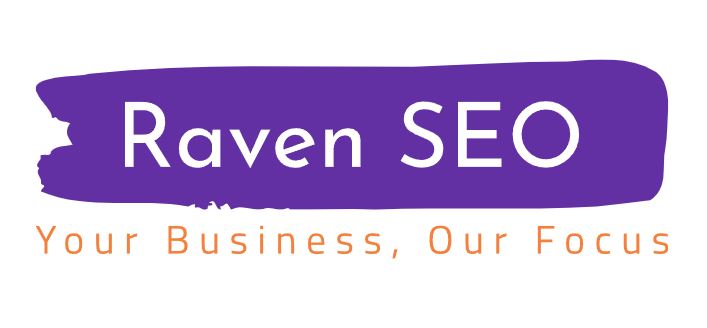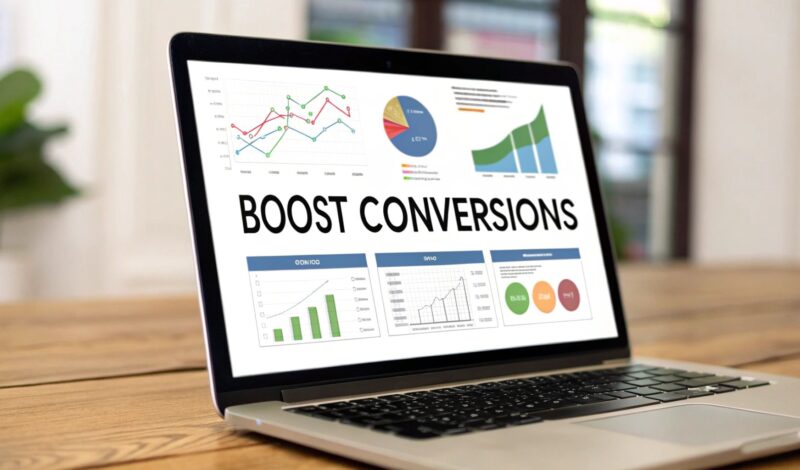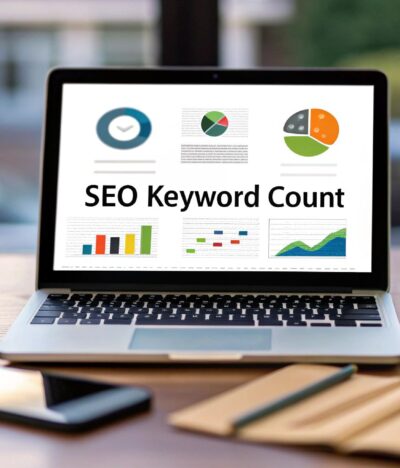Getting traffic to your website is only half the battle. The real challenge, and where true growth happens, is turning those visitors into customers, clients, or subscribers. This process, known as Conversion Rate Optimization (CRO), is a systematic approach to increasing the percentage of visitors who take a desired action. If your conversion rates are flat, you’re leaving potential revenue on the table with every click.
This article provides a detailed roadmap with eight powerful, data-backed conversion rate optimization tips that go beyond the basics. We’re not just talking about changing button colors; we’re diving into the strategic psychology and technical precision required to make meaningful improvements. You’ll learn how to simplify user journeys, build undeniable trust, and create a sense of urgency. For example, understanding practical tactics like how to add a countdown timer to your website to boost urgency and sales can directly impact your bottom line by encouraging immediate action.
For small businesses in Baltimore, e-commerce retailers in Maryland, and professional service firms across the region, these insights are designed to be immediately applicable. We will move past generic advice and provide a practical guide to help you systematically diagnose issues and implement effective solutions. From A/B testing and page speed optimization to crafting compelling value propositions and leveraging social proof, each tip is a piece of the puzzle. By the end of this list, you’ll have a clear framework for making incremental changes that deliver significant, measurable results, transforming your website from a simple brochure into a powerful conversion engine.
1. A/B Testing and Multivariate Testing
Guesswork is the enemy of growth. Instead of relying on intuition to make website changes, data-driven testing provides definitive answers about what your audience truly prefers. This is where A/B testing, also known as split testing, becomes one of the most powerful conversion rate optimization tips in your arsenal. The core concept is simple: you create two versions of a webpage or element (A and B) and show them to different segments of your audience to see which one performs better against a specific goal, like form submissions or sales.
Multivariate testing expands on this by testing multiple variables simultaneously to see which combination produces the best results. For example, you could test two different headlines, three call-to-action buttons, and two images all at once. This method is more complex and requires significant traffic but provides deeper insights into how different elements interact with each other. For businesses in Baltimore and beyond, this scientific approach removes subjectivity and builds a repeatable process for improvement.
How to Implement Effective A/B Testing
Getting started with testing doesn’t have to be complicated. By following a structured process, you can ensure your results are reliable and lead to meaningful improvements.
- Start with a Hypothesis: Don’t test random ideas. Begin with a clear hypothesis based on data or user feedback. For example, “Changing the CTA button text from ‘Submit’ to ‘Get My Free Quote’ will increase form submissions because it more clearly states the value.”
- Isolate One Variable: In a standard A/B test, change only one element at a time (e.g., just the headline or just the button color). This ensures you can attribute any change in performance directly to that specific modification.
- Ensure Statistical Significance: To trust your results, you need a large enough sample size and a long enough test duration. Aim for a statistical confidence level of at least 95%. Tools like Optimizely, VWO, and the free Google Optimize handle these calculations for you.
- Document Everything: Keep a detailed log of every test you run, including your hypothesis, the variants, the results, and your conclusions. This creates a valuable knowledge base that prevents repeating mistakes and informs future strategies.
The following infographic highlights the dramatic impact that structured A/B testing can have on key business metrics.
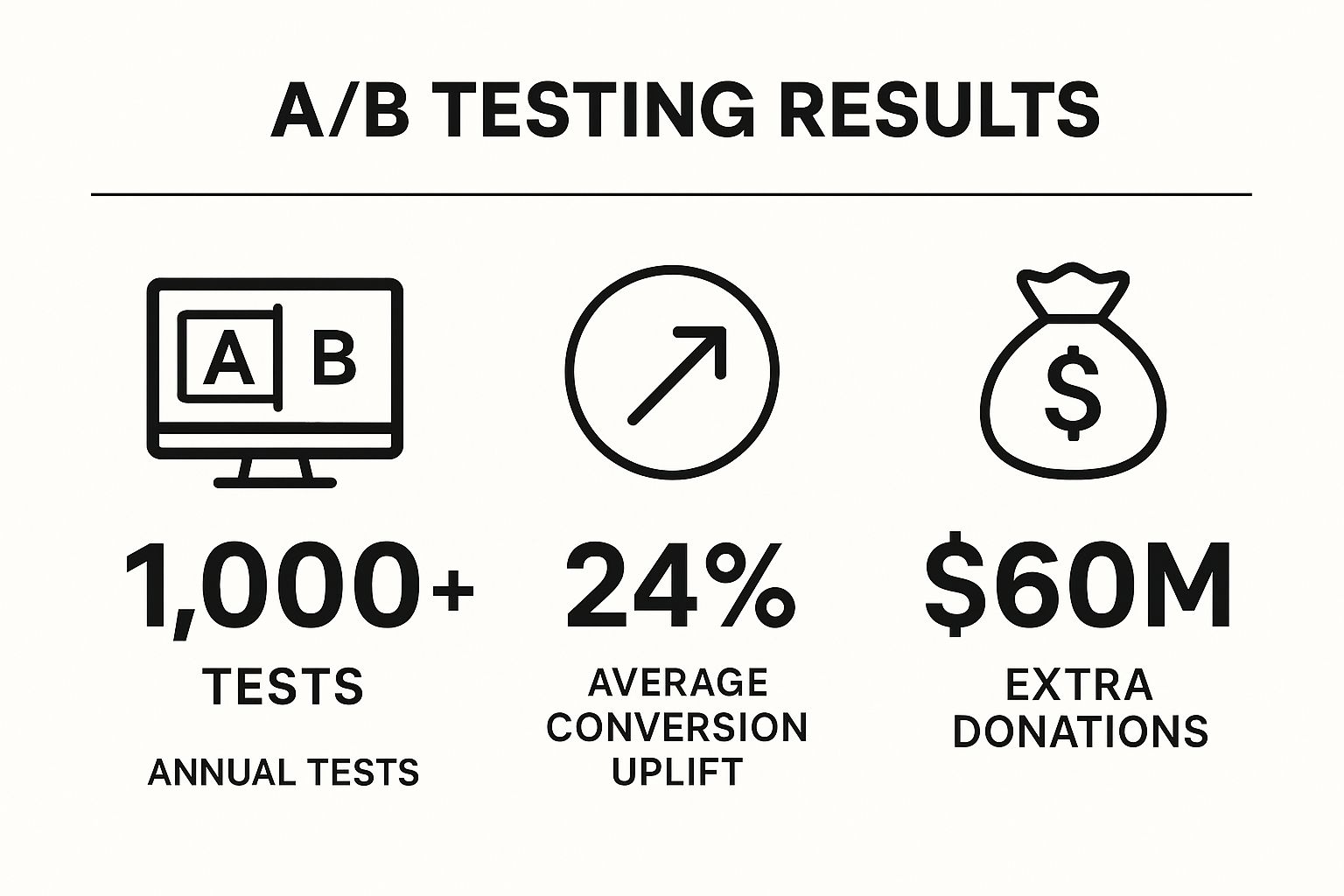
These figures demonstrate that consistent testing isn’t just an academic exercise; it’s a direct driver of significant revenue growth and conversion improvements.
For a deeper dive into setting up and running your first tests, this video from CXL, a leader in conversion optimization training, provides an excellent overview.
2. Optimize Page Load Speed
In an age of instant gratification, a slow website is one of the quickest ways to lose a potential customer. Page load speed optimization focuses on reducing the time it takes for your webpage to fully display content. Research consistently shows that faster-loading pages have significantly higher conversion rates, as users become impatient and abandon slow sites. Every second of delay can result in measurable drops in conversions, making speed optimization one of the most impactful conversion rate optimization tips.
The real-world impact is staggering. Amazon famously calculated that every 100ms of latency cost them 1% in sales, while Walmart discovered that for every one-second improvement in page load time, their conversions increased by 2%. For businesses in Baltimore and beyond, these figures underscore a critical truth: speed isn’t just a technical metric; it’s a core component of the user experience that directly influences your bottom line.
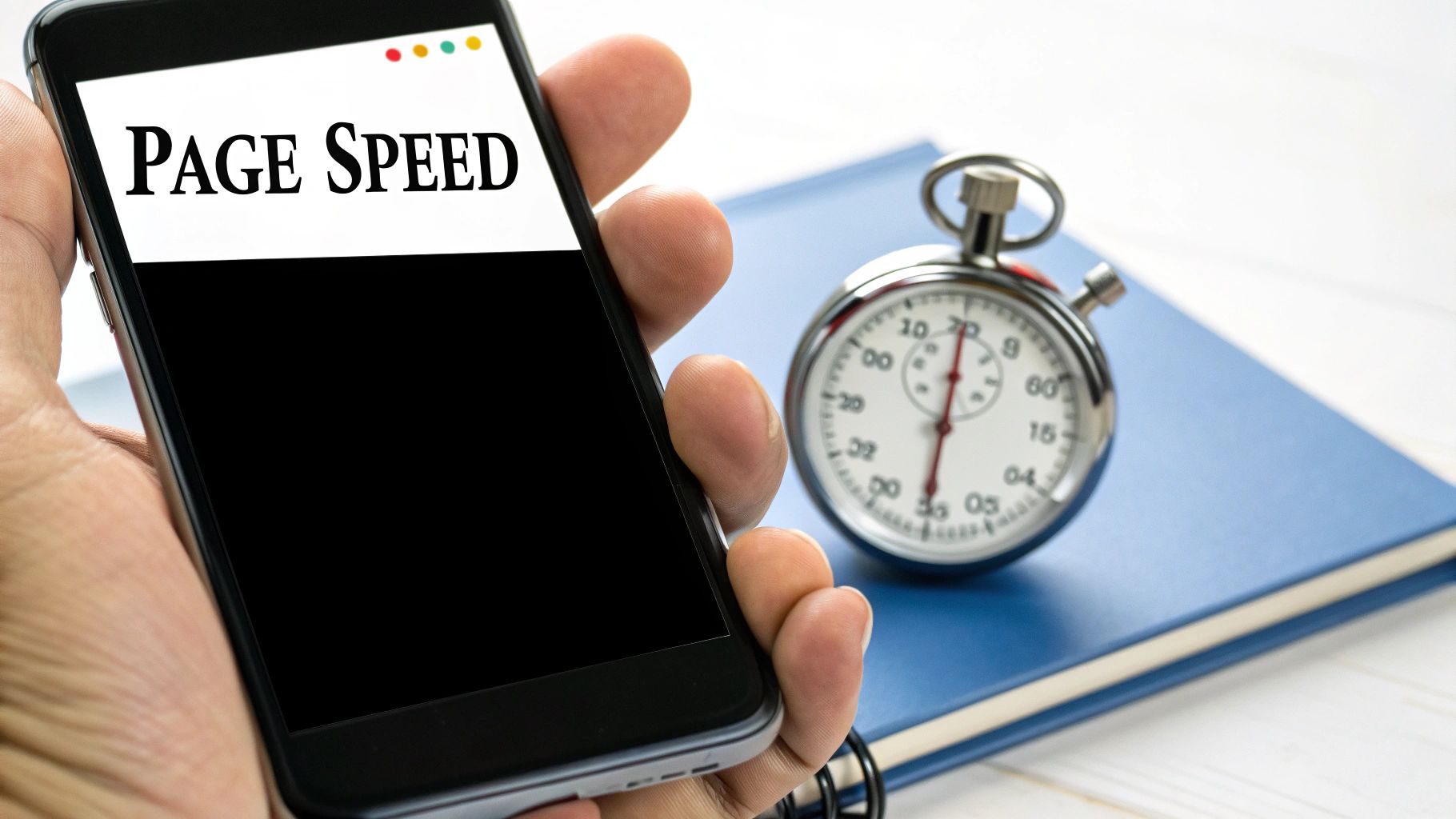
How to Implement Page Speed Optimization
Improving your site’s speed involves a series of technical adjustments that can yield significant results. By following a structured approach, you can systematically identify and eliminate performance bottlenecks.
- Benchmark Your Performance: Start by running your site through tools like Google PageSpeed Insights or GTmetrix. These platforms will analyze your URL and provide a detailed report on what’s slowing it down, offering a clear roadmap for improvement.
- Optimize Your Images: Large, uncompressed images are a common cause of slow load times. Use tools like TinyPNG or ImageOptim to compress images without sacrificing quality. Also, implement lazy loading so images below the fold only load as the user scrolls down to them.
- Leverage Browser Caching and Compression: Enable GZIP compression on your server to reduce the size of your CSS, HTML, and JavaScript files. Set up browser caching so repeat visitors don’t have to re-download all your assets every time they visit.
- Use a Content Delivery Network (CDN): A CDN stores copies of your website in multiple geographic locations. This allows users to download content from a server closer to them, dramatically reducing latency and speeding up load times for a global or regional audience.
Aim for a load time under three seconds, with under two seconds being the gold standard. Even minor improvements can prevent visitor frustration and lead to a noticeable lift in conversions.
For a comprehensive guide on identifying and fixing the issues that make your site slow, you can learn more about why website speed matters and how to fix it{:target=”_blank” rel=”noopener”}.
3. Simplify Forms and Reduce Friction
Every field in your form is a potential point of friction, a small hurdle that might cause a user to abandon the process. Since forms are the final gateway to conversion for leads, sign-ups, and sales, optimizing them is one of the most impactful conversion rate optimization tips you can implement. The goal is to make the user’s journey as effortless as possible. By reducing the cognitive load and time commitment required, you directly address user hesitation and significantly boost completion rates.
This principle is about more than just aesthetics; it’s about respecting the user’s time and data. Expedia famously increased annual profits by $12 million simply by removing one non-essential field (“Company Name”) from their booking form. Similarly, Marketo saw a 34% increase in conversions by cutting their form fields from nine to five. For businesses in Baltimore, from professional services to e-commerce, a streamlined form can be the difference between a lost visitor and a new customer.
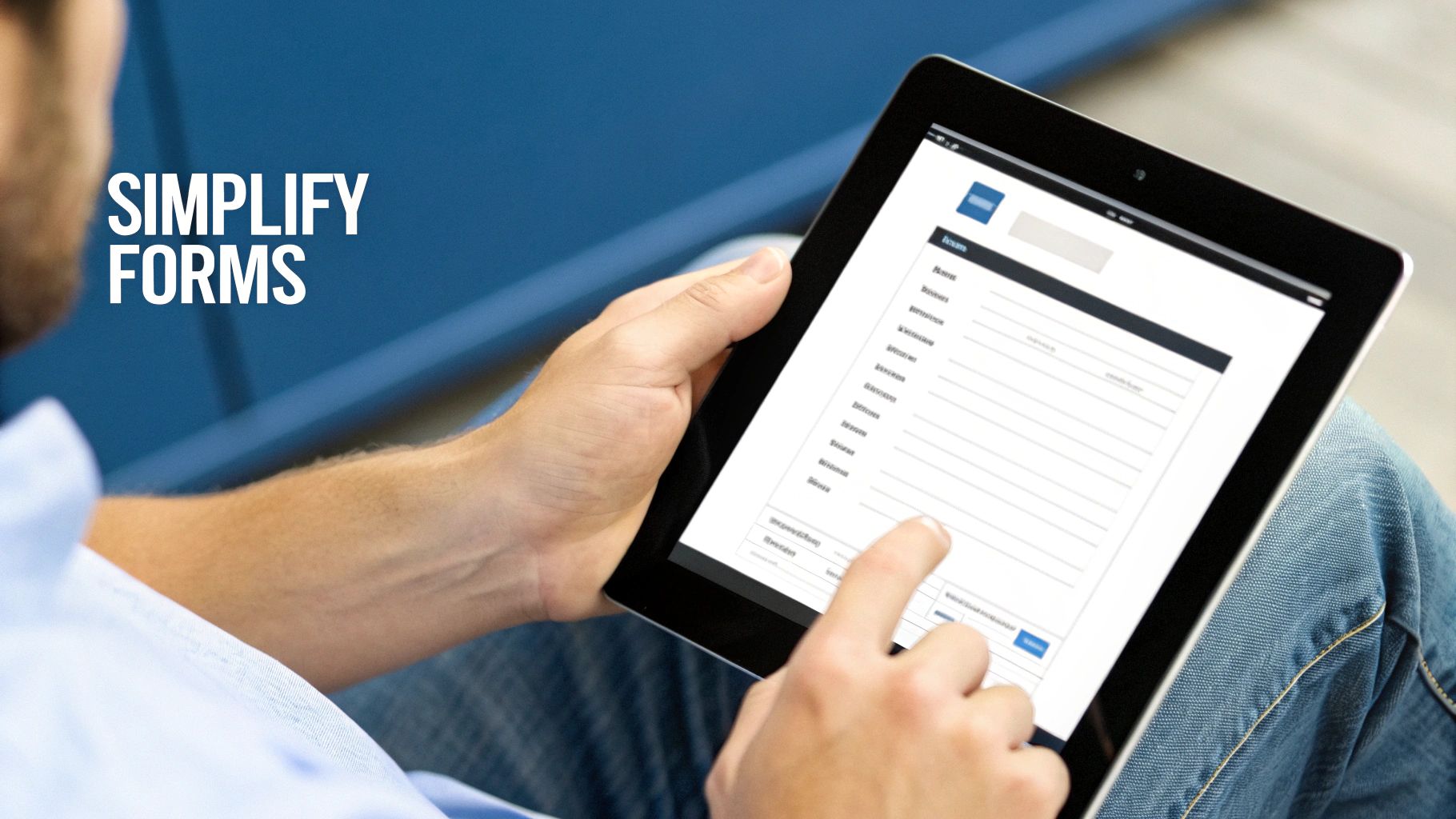
How to Implement Frictionless Forms
Optimizing your forms involves a strategic, user-centric approach. By systematically removing barriers, you can create a seamless experience that encourages completion.
- Audit Every Field: Challenge the necessity of each field. Only ask for information you absolutely need for that specific conversion step. For example, if you’re offering a downloadable guide, do you really need a phone number right away? You can always gather more information later.
- Improve Layout and Usability: A single-column layout is generally easier for users to scan and complete, especially on mobile devices. Use clear, descriptive labels for each field and make any optional fields explicitly clear with text like “(optional)”.
- Provide Real-Time Feedback: Implement inline validation to give users instant feedback as they fill out the form. A green checkmark for a correctly formatted email or a red error message for a missed required field prevents frustration when they hit the submit button.
- Set Clear Expectations: For longer or multi-step forms, use a progress bar to show users how far along they are. This manages expectations and reduces the likelihood of abandonment. Ensure your call-to-action button uses clear, action-oriented text like “Get My Free Audit” instead of a generic “Submit”.
For an in-depth look at the psychology and best practices behind form design, we recommend exploring the work of Luke Wroblewski, a recognized expert in the field. His book, “Web Form Design,” provides foundational principles that remain highly relevant.
4. Create Compelling and Clear Call-to-Action (CTA) Buttons
The call-to-action (CTA) is the tipping point where a passive visitor becomes an active lead or customer. It’s the “Go” button for your desired conversion, yet it’s often an afterthought. Optimizing your CTAs involves a strategic approach to their copy, color, size, and placement to make them impossible to ignore and easy to understand. A well-crafted CTA removes friction and ambiguity, directly telling users what to do next and what value they will receive in return.
This focus on clarity and persuasion is a cornerstone of conversion rate optimization tips. Minor changes can yield major results. For instance, Performable famously saw a 200% increase in clicks by changing their CTA from “Free Trial” to “Try It Free.” Similarly, Unbounce discovered that in one of their tests, orange buttons converted 32.5% better than green ones. These examples highlight that every element of your CTA matters and contributes directly to your conversion rate.
How to Implement Effective CTAs
Building a high-converting CTA requires more than just picking a bright color. A systematic approach ensures your buttons attract attention and drive action.
- Use Action-Oriented, First-Person Copy: Instead of the generic “Submit,” use specific, value-driven text. Phrasing it from the user’s perspective, like “Start My Free 30-Day Trial” instead of “Start Your Free 30-Day Trial,” has been shown to increase clicks by up to 90% because it creates a sense of ownership.
- Create Visual Contrast: Your CTA button should stand out from the rest of the page. Use a color that contrasts with your website’s background and surrounding elements. Strategic use of whitespace around the button also helps it draw the eye.
- Be Specific About the Outcome: Users want to know what will happen when they click. A CTA like “Download the Free Ebook” is far more effective than “Click Here” because it sets a clear expectation and communicates the benefit.
- Optimize for Size and Placement: The button must be large enough to be easily seen and clicked, especially on mobile devices. Whenever possible, place your primary CTA “above the fold” so visitors see it without scrolling. However, for complex offers, placing a CTA after the value proposition can be more effective.
5. Leverage Social Proof and Trust Signals
Humans are social creatures who often look to the actions of others to guide their own decisions. This psychological principle, popularized by Robert Cialdini in his book Influence, is the foundation of social proof. By showing visitors that other people have purchased, used, and benefited from your product or service, you reduce their uncertainty and build powerful momentum toward conversion. This is one of the most effective conversion rate optimization tips for building confidence and overcoming buyer hesitation.
Trust signals work in tandem with social proof to alleviate anxiety. These are elements like security badges, guarantees, and professional credentials that signal your website is safe and your business is legitimate. For example, WikiJob saw a 34% increase in conversions simply by adding trust symbols to their page. For businesses in Baltimore, from e-commerce stores to local service providers, effectively displaying these signals can be the deciding factor for a potential customer choosing you over a competitor.
How to Implement Social Proof and Trust Signals
Integrating these elements strategically can significantly boost your credibility. Focus on placing them near key decision-making points on your site, such as product pages, pricing tables, and checkout forms.
- Use Specific, Authentic Testimonials: Move beyond generic praise. A testimonial like “This service increased our lead flow by 45% in three months” is far more compelling than “Great service!” For maximum authenticity, include full names, company names, and photos of the people providing the testimonials.
- Showcase Data and Numbers: Quantifiable proof is highly persuasive. Displaying figures like “Trusted by 10,000+ businesses in Maryland” or showing real-time activity such as “25 people just bought this” creates a sense of popularity and urgency.
- Display Trust Badges Prominently: Don’t hide your security credentials. Place SSL certificates, secure payment logos (Visa, PayPal), and any industry awards or accreditations in your site’s footer and throughout the checkout process to reassure users their information is safe. You can discover more about building brand trust on raven-seo.com.
- Leverage Client Logos and Case Studies: If you serve notable clients, displaying their logos acts as a powerful endorsement. For more complex services, detailed case studies that outline the problem, your solution, and the positive results can effectively demonstrate your value proposition.
6. Implement Mobile-First Responsive Design
In today’s digital landscape, your website’s mobile experience isn’t just a feature; it’s the foundation of your online presence. With mobile traffic consistently surpassing desktop for most industries, prioritizing users on smartphones is no longer optional. This is where a mobile-first approach, one of the most critical conversion rate optimization tips, becomes essential. It involves designing your website for the smallest screen first and then progressively enhancing it for larger screens like tablets and desktops. This strategy ensures that the core user experience is fast, intuitive, and effective for the majority of your visitors.
This approach goes beyond simply making a desktop site shrink to fit a mobile screen. It forces you to prioritize the most crucial content and calls-to-action, leading to a cleaner, more focused design across all devices. For businesses in Baltimore, where customers are often searching for services on the go, a seamless mobile experience can be the deciding factor between a conversion and a bounce. Success stories from brands like Walmart, which directly correlated mobile speed improvements with conversion increases, prove the immense value of this strategy.
How to Implement a Mobile-First Strategy
Adopting a mobile-first mindset requires a shift in how you plan, design, and develop your website. By focusing on the unique constraints and advantages of mobile, you can create a superior user experience that drives conversions.
- Design for Thumbs: Place key navigation elements, buttons, and CTAs within the natural sweep of a user’s thumb, typically at the bottom or middle of the screen. This makes interaction effortless and intuitive.
- Use Large Touch Targets: Ensure all clickable elements, like buttons and links, are at least 44×44 pixels. This prevents frustrating mis-taps and improves usability, a key principle in modern website design.
- Simplify Navigation and Forms: Condense complex menus into a “hamburger” icon or a simplified list. For forms, use mobile-friendly input types (like a number pad for phone numbers) and break longer forms into multiple steps.
- Prioritize Performance: Mobile users are often on slower connections and have less patience. Optimize images, minify code, and leverage browser caching to ensure your site loads lightning-fast. Even a one-second delay can drastically reduce conversions.
- Test on Real Devices: While emulators are helpful, nothing beats testing your site on actual iPhones and Android devices. This helps you catch platform-specific bugs and experience your site exactly as your users do.
By building from the ground up for mobile users, you create a more resilient and effective website that caters to the modern consumer. For more guidance on creating an effective online presence, check out these 10 website design best practices for SMBs.
7. Use Persuasive Copywriting and Value Propositions
Your website’s design can capture attention, but it’s the words on the page that ultimately convince a user to act. Persuasive copywriting is the art of crafting compelling messages that clearly communicate your unique value proposition and motivate visitors to convert. This involves a deep understanding of your audience’s needs, pain points, and desires, then addressing them with benefit-focused language that emphasizes outcomes over features. A strong value proposition instantly answers the user’s question: “What’s in it for me?”
Effective copy bridges the gap between what your product does and why a customer should care. Instead of just listing features, it tells a story about transformation. For example, instead of saying “Our software has a calendar integration,” persuasive copy says “Effortlessly sync your team’s schedule and never miss a deadline again.” This approach, used by countless successful brands in Baltimore and worldwide, helps users quickly understand why your solution is the right choice, making it one of the most fundamental conversion rate optimization tips.
How to Implement Persuasive Copywriting
Crafting copy that converts is a skill that blends psychology with clear communication. By following a structured approach, you can turn passive readers into active customers.
- Lead with a Benefit-Driven Headline: Your headline is your first and most important impression. Instead of describing your service, state the primary benefit the user will receive. Highrise, a CRM software, increased sign-ups by 30% simply by changing its headline from a feature (“30-Day Free Trial on All Accounts”) to a benefit (“Start a Highrise Account in Seconds”).
- Focus on ‘You’, Not ‘We’: Make your copy about the customer. Use words like “you” and “your” to speak directly to their challenges and goals. This simple shift in perspective makes your message more personal, relatable, and engaging.
- Use the PAS Framework: A classic and powerful copywriting formula is Problem, Agitation, Solution. First, identify the reader’s Problem. Next, Agitate that problem by describing the frustrations it causes. Finally, present your product as the Solution. This framework creates a narrative that resonates emotionally. To truly master the art of convincing your audience and enhancing your value propositions, explore these powerful persuasive writing techniques.
- Keep it Clear and Readable: Great copy is easy to understand. Use short sentences, small paragraphs, and bullet points to break up text. Making your content highly readable is a secret weapon for keeping users engaged and guiding them toward conversion. For more insights on this, you can learn more about improving content readability.
8. Optimize for User Intent with Personalization
Treating every visitor the same is a missed opportunity. Personalization is the practice of tailoring the user experience to individual visitors based on their characteristics, behavior, and where they are in the buyer’s journey. By showing relevant content, offers, and messaging to different audience segments, you can create a more engaging and effective path to conversion. This powerful approach recognizes that a first-time visitor from a social media ad has different needs than a returning customer browsing from their email newsletter.
This strategy moves beyond a one-size-fits-all website and creates dynamic experiences that resonate on a personal level. Giants like Amazon, which generates an estimated 35% of its revenue from personalized recommendations, have proven the model’s effectiveness. For businesses in Baltimore, leveraging personalization means showing a local offer to a visitor from Maryland or different messaging to someone who has previously purchased a specific service. It’s one of the most direct conversion rate optimization tips for building relevance and trust.
How to Implement Effective Personalization
You don’t need Amazon’s budget to get started. Effective personalization can begin with simple segmentation and scale as you gather more data.
- Start with Simple Segmentation: Begin by creating different experiences for new versus returning visitors. A returning visitor could be greeted with a “Welcome Back!” message and shown products related to their last session, while a new visitor might see a first-time purchase discount.
- Personalize Based on Traffic Source: Tailor landing page headlines and offers based on where the user came from. A visitor arriving from a “discount software” Google ad should see a different page than someone who clicked a link in a blog post about industry trends. Understanding their initial motivation is key, which is deeply tied to their search intent. You can learn more about optimizing for search intent on raven-seo.com.
- Use Behavioral and Contextual Data: Show location-specific content like local currency, language, or store information. You can also display different calls-to-action based on the device type (e.g., “Call Now” on mobile vs. “Schedule a Demo” on desktop) or use exit-intent popups with targeted offers to prevent cart abandonment.
- Implement Product Recommendations: Based on a user’s browsing history, past purchases, or items currently in their cart, you can display “You might also like” or “Frequently bought together” sections. This tactic alone helped Dell increase conversions by 30%.
Conversion Rate Optimization Tips Comparison
| Strategy | Implementation Complexity (🔄) | Resource Requirements (⚡) | Expected Outcomes (⭐📊) | Ideal Use Cases (💡) | Key Advantages (⭐) |
|---|---|---|---|---|---|
| A/B Testing and Multivariate Testing | Medium to High | Moderate to High (traffic & tools) | Reliable data-driven conversion improvements | Optimizing webpages, emails; testing multiple elements | Quantifiable ROI; continuous improvement; user insights |
| Optimize Page Load Speed | Medium to High | High (technical & infrastructure) | Faster page loads; reduced bounce; SEO boost | Sites with speed bottlenecks; mobile-heavy traffic | Direct conversion impact; better UX; SEO improvement |
| Simplify Forms and Reduce Friction | Low to Medium | Low to Medium (UX design, testing) | Increased form completions and lower abandonment | Checkout forms; lead capture forms | Higher completion rates; better mobile UX; less frustration |
| Create Compelling CTAs | Low | Low | Quick lifts in clicks and conversions | Any page with user action goals | Immediate impact; low cost; clarifies user next steps |
| Leverage Social Proof and Trust Signals | Low | Low | Increased trust and conversions | New products; overcoming buyer hesitation | Builds credibility; reduces anxiety; easy to implement |
| Implement Mobile-First Responsive Design | Medium to High | Medium to High (design & dev resources) | Improved mobile engagement and conversions | Mobile-heavy traffic; mobile-critical sites | Captures mobile traffic; SEO benefits; better UX |
| Use Persuasive Copywriting and Value Propositions | Low to Medium | Low to Medium (writing & research) | Clear messaging; increased motivation to convert | Landing pages, product pages, ads | Differentiates brand; improves clarity; quick to test |
| Optimize for User Intent with Personalization | High | High (data, tools, analytics) | Higher relevance; segmented user conversions | E-commerce, content platforms, B2B marketing | Better ROI; improved CX; shorter sales cycles |
Putting It All Together: Your Path to Higher Conversions
You’ve just navigated a comprehensive list of powerful conversion rate optimization tips, each one a vital cog in the machine that turns casual visitors into loyal customers and qualified leads. The journey from a static, underperforming website to a dynamic, high-converting digital asset is not a sprint; it’s a marathon of strategic, incremental improvements. It’s about building a system, not just deploying a few isolated tactics.
The common thread weaving through all eight of these strategies, from A/B testing to personalized user experiences, is a relentless focus on the user. Conversion Rate Optimization (CRO) is ultimately about empathy. It’s about understanding your audience’s pain points, anticipating their needs, and removing every obstacle that stands between them and their goal. When you make their journey effortless and valuable, conversions become a natural byproduct.
Recapping Your CRO Toolkit
Let’s quickly revisit the core principles we’ve covered. Think of these not as a checklist to be completed once, but as a continuous cycle of improvement:
- Testing is Non-Negotiable: A/B and multivariate testing are your windows into user behavior. They replace guesswork with data, allowing you to validate changes and compound small wins over time.
- Speed is a Feature: Optimizing page load speed is a fundamental sign of respect for your user’s time. A faster site improves user experience, boosts SEO, and directly impacts your bottom line.
- Simplicity Wins: Complicated forms and confusing navigation are conversion killers. By simplifying forms and reducing friction, you make it easy for users to say “yes.”
- Clarity Drives Action: Your Call-to-Action (CTA) buttons must be impossible to miss and incredibly clear. They are the final signpost guiding users to the desired action.
- Trust is Your Currency: Social proof and trust signals, like testimonials and security badges, alleviate anxiety and build the confidence necessary for a user to convert.
- Mobile is a Mandate: With a significant portion of web traffic coming from mobile devices, a mobile-first design isn’t a luxury; it’s a requirement for survival and growth.
- Words Matter: Persuasive copywriting and a powerful value proposition communicate why a user should choose you over anyone else. This is where you connect emotionally and logically with your audience.
- Personalization Creates Connection: Tailoring content and offers to user intent makes visitors feel understood and valued, dramatically increasing the relevance of your message.
Your Actionable Next Steps
Feeling overwhelmed by the possibilities? Don’t be. The most effective approach to implementing these conversion rate optimization tips is to start small and build momentum. Choose one or two areas from this list that you believe will have the most significant impact on your specific business goals.
Perhaps you suspect your lengthy contact form is scaring away potential leads. Start by A/B testing a shorter version. Maybe you’ve never looked at your site’s mobile performance. Use Google’s PageSpeed Insights to get a baseline score and identify low-hanging fruit. The key is to start doing.
Commit to a process:
- Identify a potential problem area.
- Hypothesize a solution.
- Test your hypothesis with a controlled experiment.
- Analyze the results.
- Implement the winner or learn from the results and repeat.
By adopting this disciplined, iterative mindset, you transform CRO from a daunting project into a manageable and ongoing business process. Each test, whether it wins or loses, provides invaluable insight into your customers. This is how you build not just a better website, but a smarter, more customer-centric business.
Turning these insights into a cohesive, data-driven strategy takes expertise and resources. If you’re a Baltimore or Maryland-based business ready to stop guessing and start growing, the team at Raven SEO specializes in creating and executing CRO roadmaps that deliver tangible results. Let us help you translate these conversion rate optimization tips into a customized plan that boosts your revenue.
